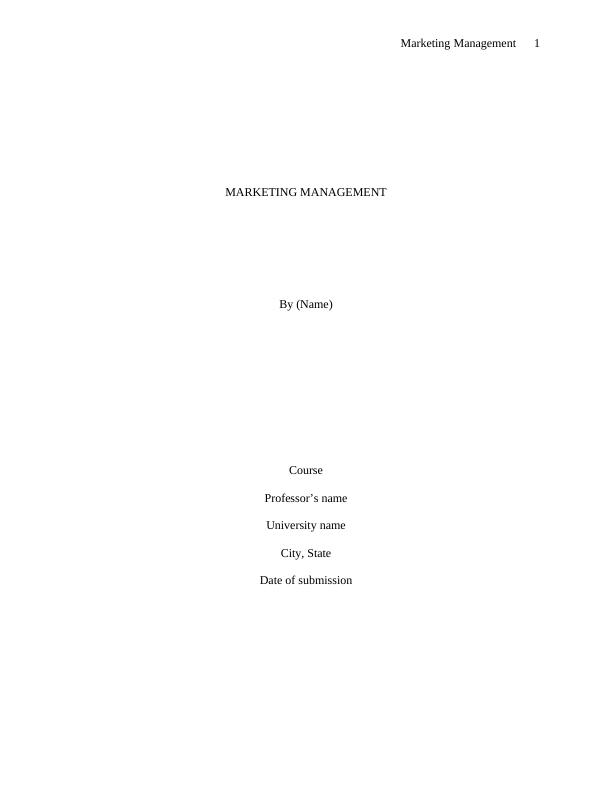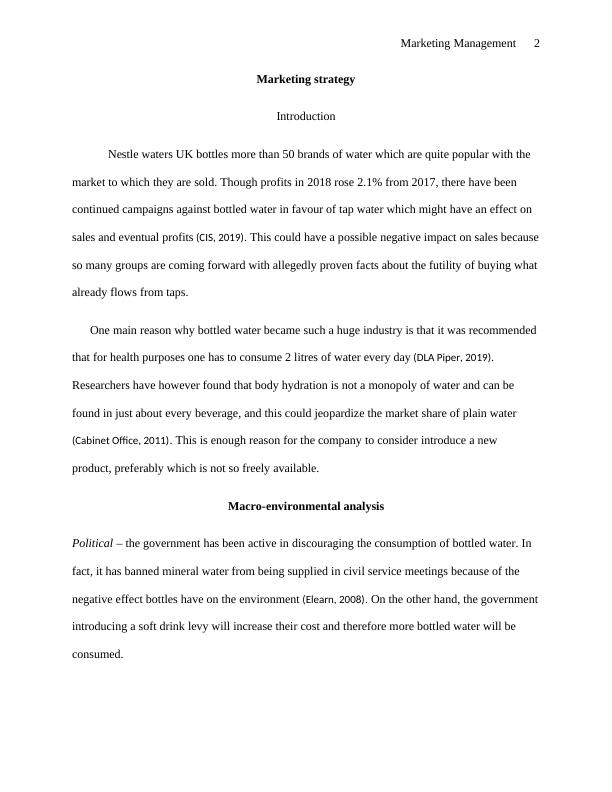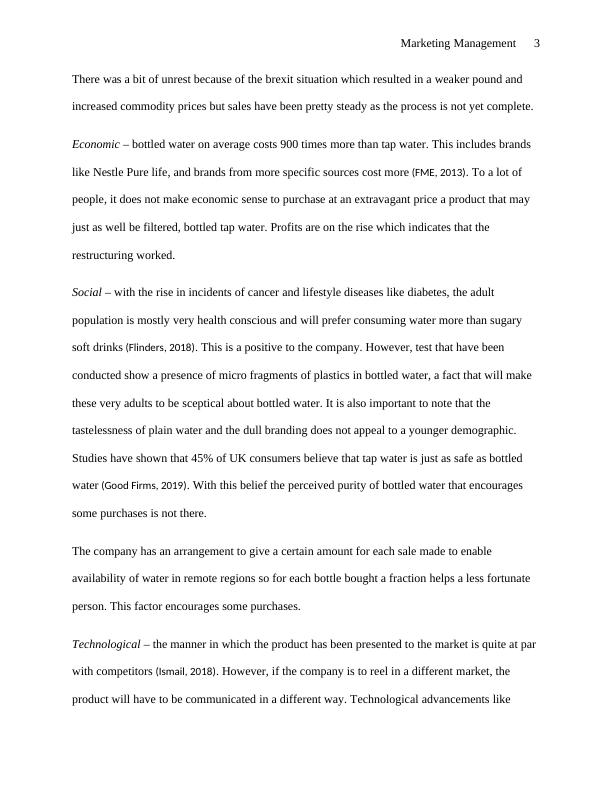Marketing Management
Added on 2023-04-11
14 Pages3250 Words447 Views
Marketing Management 1
MARKETING MANAGEMENT
By (Name)
Course
Professor’s name
University name
City, State
Date of submission
MARKETING MANAGEMENT
By (Name)
Course
Professor’s name
University name
City, State
Date of submission

Marketing Management 2
Marketing strategy
Introduction
Nestle waters UK bottles more than 50 brands of water which are quite popular with the
market to which they are sold. Though profits in 2018 rose 2.1% from 2017, there have been
continued campaigns against bottled water in favour of tap water which might have an effect on
sales and eventual profits (CIS, 2019). This could have a possible negative impact on sales because
so many groups are coming forward with allegedly proven facts about the futility of buying what
already flows from taps.
One main reason why bottled water became such a huge industry is that it was recommended
that for health purposes one has to consume 2 litres of water every day (DLA Piper, 2019).
Researchers have however found that body hydration is not a monopoly of water and can be
found in just about every beverage, and this could jeopardize the market share of plain water
(Cabinet Office, 2011). This is enough reason for the company to consider introduce a new
product, preferably which is not so freely available.
Macro-environmental analysis
Political – the government has been active in discouraging the consumption of bottled water. In
fact, it has banned mineral water from being supplied in civil service meetings because of the
negative effect bottles have on the environment (Elearn, 2008). On the other hand, the government
introducing a soft drink levy will increase their cost and therefore more bottled water will be
consumed.
Marketing strategy
Introduction
Nestle waters UK bottles more than 50 brands of water which are quite popular with the
market to which they are sold. Though profits in 2018 rose 2.1% from 2017, there have been
continued campaigns against bottled water in favour of tap water which might have an effect on
sales and eventual profits (CIS, 2019). This could have a possible negative impact on sales because
so many groups are coming forward with allegedly proven facts about the futility of buying what
already flows from taps.
One main reason why bottled water became such a huge industry is that it was recommended
that for health purposes one has to consume 2 litres of water every day (DLA Piper, 2019).
Researchers have however found that body hydration is not a monopoly of water and can be
found in just about every beverage, and this could jeopardize the market share of plain water
(Cabinet Office, 2011). This is enough reason for the company to consider introduce a new
product, preferably which is not so freely available.
Macro-environmental analysis
Political – the government has been active in discouraging the consumption of bottled water. In
fact, it has banned mineral water from being supplied in civil service meetings because of the
negative effect bottles have on the environment (Elearn, 2008). On the other hand, the government
introducing a soft drink levy will increase their cost and therefore more bottled water will be
consumed.

Marketing Management 3
There was a bit of unrest because of the brexit situation which resulted in a weaker pound and
increased commodity prices but sales have been pretty steady as the process is not yet complete.
Economic – bottled water on average costs 900 times more than tap water. This includes brands
like Nestle Pure life, and brands from more specific sources cost more (FME, 2013). To a lot of
people, it does not make economic sense to purchase at an extravagant price a product that may
just as well be filtered, bottled tap water. Profits are on the rise which indicates that the
restructuring worked.
Social – with the rise in incidents of cancer and lifestyle diseases like diabetes, the adult
population is mostly very health conscious and will prefer consuming water more than sugary
soft drinks (Flinders, 2018). This is a positive to the company. However, test that have been
conducted show a presence of micro fragments of plastics in bottled water, a fact that will make
these very adults to be sceptical about bottled water. It is also important to note that the
tastelessness of plain water and the dull branding does not appeal to a younger demographic.
Studies have shown that 45% of UK consumers believe that tap water is just as safe as bottled
water (Good Firms, 2019). With this belief the perceived purity of bottled water that encourages
some purchases is not there.
The company has an arrangement to give a certain amount for each sale made to enable
availability of water in remote regions so for each bottle bought a fraction helps a less fortunate
person. This factor encourages some purchases.
Technological – the manner in which the product has been presented to the market is quite at par
with competitors (Ismail, 2018). However, if the company is to reel in a different market, the
product will have to be communicated in a different way. Technological advancements like
There was a bit of unrest because of the brexit situation which resulted in a weaker pound and
increased commodity prices but sales have been pretty steady as the process is not yet complete.
Economic – bottled water on average costs 900 times more than tap water. This includes brands
like Nestle Pure life, and brands from more specific sources cost more (FME, 2013). To a lot of
people, it does not make economic sense to purchase at an extravagant price a product that may
just as well be filtered, bottled tap water. Profits are on the rise which indicates that the
restructuring worked.
Social – with the rise in incidents of cancer and lifestyle diseases like diabetes, the adult
population is mostly very health conscious and will prefer consuming water more than sugary
soft drinks (Flinders, 2018). This is a positive to the company. However, test that have been
conducted show a presence of micro fragments of plastics in bottled water, a fact that will make
these very adults to be sceptical about bottled water. It is also important to note that the
tastelessness of plain water and the dull branding does not appeal to a younger demographic.
Studies have shown that 45% of UK consumers believe that tap water is just as safe as bottled
water (Good Firms, 2019). With this belief the perceived purity of bottled water that encourages
some purchases is not there.
The company has an arrangement to give a certain amount for each sale made to enable
availability of water in remote regions so for each bottle bought a fraction helps a less fortunate
person. This factor encourages some purchases.
Technological – the manner in which the product has been presented to the market is quite at par
with competitors (Ismail, 2018). However, if the company is to reel in a different market, the
product will have to be communicated in a different way. Technological advancements like

Marketing Management 4
social media have brought about an easier way not only to communicate products to the market
but to also interact with it.
Environmental – bottled water companies unavoidably have a much larger carbon footprint than
tap water, almost to the tune of a thousand times, mostly because of packaging and
transportation. The company has introduced light-weighting which makes too small a difference
and recycling which is a bit futile because recycled Polyethene terephthalate gives weaker
plastics. The plastics, which are single use, are not biodegradable and take close to 450 years to
be broken down; therefore they are not environmentally friendly as is expected (Klever, 2008).
Emissions are however within limits set by government environmental bodies.
Legal – standards for the quality of products are set and must be followed to avoid legal
implications. So far there have been no complaints about quality.
Growth opportunity
Even though Nestle Water holds the largest market share for bottled water in the world,
the company has specialized in spring water, mineral water and prepared water. The section of
the market that prefers flavoured water or just is not willing to buy plain water does not have a
Nestle water product to choose from. This is whole market section which is not being explored
(Kotler, 2012). The fact that reusable water bottles are now being made to include filters in some
parts of the world, and that drinking fountains are being actively installed means that demand for
bottled water may get low with time. The bottles are single-use and have to be disposed of
immediately after use which causes devastating effects to the environment. These factors if
altered just a bit present a whole product idea.
social media have brought about an easier way not only to communicate products to the market
but to also interact with it.
Environmental – bottled water companies unavoidably have a much larger carbon footprint than
tap water, almost to the tune of a thousand times, mostly because of packaging and
transportation. The company has introduced light-weighting which makes too small a difference
and recycling which is a bit futile because recycled Polyethene terephthalate gives weaker
plastics. The plastics, which are single use, are not biodegradable and take close to 450 years to
be broken down; therefore they are not environmentally friendly as is expected (Klever, 2008).
Emissions are however within limits set by government environmental bodies.
Legal – standards for the quality of products are set and must be followed to avoid legal
implications. So far there have been no complaints about quality.
Growth opportunity
Even though Nestle Water holds the largest market share for bottled water in the world,
the company has specialized in spring water, mineral water and prepared water. The section of
the market that prefers flavoured water or just is not willing to buy plain water does not have a
Nestle water product to choose from. This is whole market section which is not being explored
(Kotler, 2012). The fact that reusable water bottles are now being made to include filters in some
parts of the world, and that drinking fountains are being actively installed means that demand for
bottled water may get low with time. The bottles are single-use and have to be disposed of
immediately after use which causes devastating effects to the environment. These factors if
altered just a bit present a whole product idea.

End of preview
Want to access all the pages? Upload your documents or become a member.
Related Documents
Differences Between Bottled Water And Tap Waterlg...
|7
|1795
|33
Factors Affecting Demand, CPFR and CRM Practices for Mount Franklin Water Companylg...
|12
|3611
|432
Strategic Management Assignment Coca Colalg...
|9
|1947
|882
Supply Chain Analysis of Soft Drinks (Bottled Water) Market Using SWOT Analysislg...
|23
|2341
|221
Entrepreneurship Development: Lean Start Up, Business Objectives, Customer Value Proposition Canvas, Lean Business Modellg...
|16
|4492
|35
Creative Direction for Advertising: Challenges, Solutions, and Visual Prooflg...
|11
|705
|254
